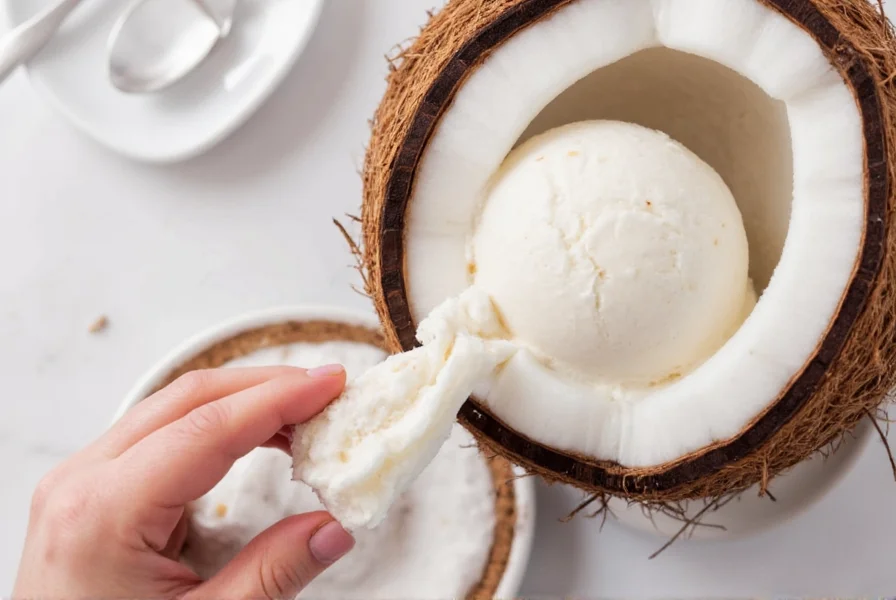DIY Recipe: Make Authentic Thai Coconut Ice Cream at Home
Craving authentic Thai coconut ice cream? This easy homemade recipe gives you the perfect tropical treat without leaving your kitchen. Here's how to make it in just a few simple steps.
Ingredients:
- 2 cups full-fat coconut cream (or a mix of coconut milk and cream)
- 1/4 cup palm sugar or brown sugar (adjust to taste)
- 1/4 tsp salt
- 1 tsp vanilla extract
- 1/2 tsp pandan extract (optional, for aroma)
- 1/2 cup heavy cream (for extra richness and texture, optional)
Instructions:
- In a bowl, whisk together coconut cream, sugar, salt, and vanilla until the sugar dissolves completely.
- Add heavy cream if you want a richer texture and smoother melt.
- Pour the mixture into an ice cream maker and churn according to manufacturer instructions until thickened (usually 20–30 minutes).
- Transfer to a container and freeze until firm.
- Serve in chilled coconut shells with a sprinkle of toasted coconut flakes or alongside mango sticky rice!

| Feature | Coconut Milk | Coconut Cream |
|---|---|---|
| Consistency | Thin, pourable | Thick, rich |
| Fat Content | ~17-24% | ~24-30% |
| Best For | Creamy soups, light curries, blended drinks | Dense curries, desserts, whipped toppings |
| Common Use in Thai Desserts | Main liquid in desserts | Base for ice cream, sauces |

For homemade Thai coconut ice cream, coconut cream is often preferred because of its higher fat content, which gives the ice cream a luscious, velvety mouthfeel. However, using a blend of both can also yield a balanced result — offering richness while keeping it light enough for easy melting.
Table of Contents
- A Slice of History: Where Did Thai Coconut Ice Cream Come From?
- Why Does Thai Coconut Ice Cream Taste So Good?
- Coconut Milk vs. Coconut Cream: What's the Difference?
- Buying Guide: Best Coconut Products for Homemade Ice Cream
- Beyond Plain Vanilla: Creative Twists on Coconut Ice Cream
- Where to Find the Best Coconut Ice Cream in Thailand
- Frequently Asked Questions (FAQ)
- Conclusion: Sweet Dreams and Coconut Creams
A Slice of History: Where Did Thai Coconut Ice Cream Come From?
While modern frozen desserts may seem like a global trend, coconut-based ice creams have roots deep in Southeast Asian culinary traditions. In Thailand, coconut has always been a staple ingredient — used not just in desserts but also in savory dishes like kaeng tai pla (spicy fish kidney curry) and massaman curry.
The idea of freezing coconut milk likely evolved from traditional iced desserts like tub tim krob (water chestnuts in coconut milk), which have long provided relief from the tropical heat. As refrigeration technology became more accessible, Thais began experimenting with blending their beloved coconut flavors into frozen delights, giving birth to what we now recognize as Thai-style coconut ice cream.
Why Does Thai Coconut Ice Cream Taste So Good?
There's something about that first spoonful of creamy, slightly sweet, and nutty coconut flavor that instantly transports you to the tropics. Here are a few reasons why Thai coconut ice cream stands out:
- Freshness First: Street vendors and local markets use fresh, high-quality coconut milk made daily.
- Perfect Balance: Thai cuisine excels at balancing flavors — even in desserts. A hint of salt and sometimes pandan or palm sugar enhance the richness of coconut without overpowering it.
- Texture Perfection: Traditional methods of churning and freezing result in a smooth, silky texture that melts beautifully on your tongue.
- Serving Style: Often served in chilled coconut shells or paired with sticky rice and mango, the presentation adds an element of surprise and authenticity.
Buying Guide: Best Coconut Products for Homemade Ice Cream
If you don't live near a tropical grove, finding quality coconut products is key to replicating Thai flavors at home. Here's a list of recommended brands and their features:
| Product | Features | Advantages | Use Case | Suitable Occasions |
|---|---|---|---|---|
| Aroy-D Coconut Milk | No preservatives, thick consistency, rich flavor | Perfect for creamy textures and deep coconut taste | Ice cream base, desserts, curries | Everyday cooking and special desserts |
| Chaokoh Coconut Cream | High-fat content, shelf-stable, easy to whip | Ideal for frozen desserts and whipped toppings | Ice cream, cakes, sauces | Entertaining, holiday baking, gift baskets |
| Taste of Thailand Coconut Milk | Authentic Thai flavor, BPA-free cans | Great balance between price and quality | Desserts, smoothies, cocktails | Weeknight meals, quick recipes |
| Native Forest Organic Coconut Milk | Organic, fair trade, no additives | Eco-friendly choice with clean label | Health-focused desserts, vegan diets | Vegan gatherings, eco-conscious kitchens |
| Maypro Coconut Cream Concentrate | Concentrated form, longer shelf life | Good for bulk cooking and commercial use | Commercial production, large batches | Restaurants, catering, cafes |
Beyond Plain Vanilla: Creative Twists on Coconut Ice Cream
Once you've mastered the basic coconut ice cream, why not jazz it up a bit? Thailand offers plenty of inspiration for adding exciting flavors and textures:
- Mango Sticky Rice Coconut Ice Cream: Blend in ripe mango puree and serve over coconut sticky rice for a triple threat of sweetness.
- Lychee & Rose: Infuse the base with rose water and fold in lychee chunks for a floral twist.
- Chili-Lime Zinger: Add a pinch of chili powder and a splash of lime juice for that perfect sweet-sour-spice combo.
- Coconut & Durian Fusion: For the adventurous eaters, a swirl of durian paste brings a bold, earthy depth to coconut.
- Toasted Coconut Crunch: Fold in finely chopped toasted coconut chips for a satisfying crunch in every bite.
Where to Find the Best Coconut Ice Cream in Thailand
If you're lucky enough to be visiting Thailand, here are some top spots to try authentic coconut ice cream:
- Raan Nid Mangala Seafood (Bangkok): Known for its seafood, but their homemade coconut ice cream steals the show.
- Klong Toey Market (Bangkok): Local market stalls offer some of the freshest, creamiest versions around.
- Khao Kha Market (Chiang Mai): Try the street vendor versions served in half coconuts with sticky rice and banana slices.
- Wat Phra Kaew Floating Market (Ayutthaya): Experience ice cream made with freshly grated coconut and coconut water straight from the source.
- Phuket Night Markets: Look for stalls serving "ไอศกรีมมะพร้าว" (coconut ice cream) with unique toppings like roasted peanuts and sweet corn.
Frequently Asked Questions (FAQ)
What makes Thai coconut ice cream different from regular ice cream?
Thai coconut ice cream uses fresh coconut milk or cream as the primary ingredient instead of dairy, giving it a distinct tropical flavor and creamy texture without lactose. It often incorporates palm sugar for sweetness and balances flavors with a pinch of salt, staying true to Thai culinary traditions.
Is Thai coconut ice cream vegan?
Traditional Thai coconut ice cream is naturally vegan since it's made exclusively with coconut-based ingredients and palm sugar. However, some modern recipes or commercial versions may include dairy like heavy cream for texture, so always check ingredients if strict vegan compliance is needed.
Can I make Thai coconut ice cream without an ice cream maker?
Yes! Pour the mixture into a shallow dish, freeze for 1 hour, then whisk vigorously every 30 minutes for 3-4 hours until creamy. This manual method mimics churning and prevents ice crystals while maintaining smooth texture.
Why is coconut so prevalent in Thai desserts?
Coconut is a staple crop in Thailand's tropical climate and has been integral to Thai cuisine for centuries. Its rich fat content creates creamy textures ideal for desserts, while its subtle sweetness complements Thai flavors without overpowering them.
Where can I find the most authentic coconut ice cream in Bangkok?
Klong Toey Market and street vendors near Wat Pho serve some of the most authentic versions, made daily with fresh coconut milk and presented in coconut shells. These locations prioritize traditional methods over commercial shortcuts.
Does traditional Thai coconut ice cream contain dairy?
No, authentic versions rely solely on coconut cream for richness. Dairy is a Western adaptation—true Thai street vendors use 100% coconut-based recipes, though some modern cafes might blend in dairy for texture.
How long does homemade coconut ice cream last in the freezer?
Properly stored in an airtight container with parchment paper pressed directly on the surface, it stays fresh for 2-3 weeks. The absence of dairy may cause it to harden faster than regular ice cream, so letting it sit at room temperature for 5 minutes before serving improves texture.
Conclusion: Sweet Dreams and Coconut Creams
Whether you're savoring a scoop under the swaying palms of Phuket or recreating the magic in your own kitchen, Thai coconut ice cream is more than just a dessert — it's a sensory journey through flavor, tradition, and technique.
So next time you reach for that carton of coconut milk in the grocery store, remember the story behind each creamy spoonful. And if you haven't tried making it yourself yet, what are you waiting for? Your taste buds might just thank you for taking them on a trip to Thailand.










 浙公网安备
33010002000092号
浙公网安备
33010002000092号 浙B2-20120091-4
浙B2-20120091-4